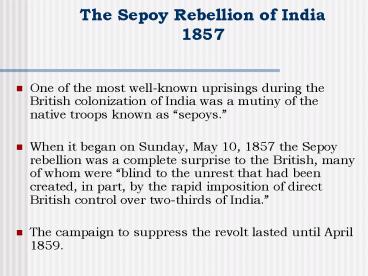The Sepoy Rebellion of India 1857 - PowerPoint PPT Presentation
1 / 7
Title:
The Sepoy Rebellion of India 1857
Description:
One of the most well-known uprisings during the British colonization of India ... entailed the biting of a greased cartridge, which the sepoys feared was made ... – PowerPoint PPT presentation
Number of Views:5465
Avg rating:3.0/5.0
Title: The Sepoy Rebellion of India 1857
1
The Sepoy Rebellion of India1857
- One of the most well-known uprisings during the
British colonization of India was a mutiny of the
native troops known as sepoys. - When it began on Sunday, May 10, 1857 the Sepoy
rebellion was a complete surprise to the British,
many of whom were blind to the unrest that had
been created, in part, by the rapid imposition of
direct British control over two-thirds of India. - The campaign to suppress the revolt lasted until
April 1859.
2
- The British East India Company began recruiting
native citizens as troops in 1667, in order to
maintain control during their trading
operations. - In 1748, the British government also began
recruiting and training Indians to fight with
their weaponry and methods. - The Indian units were called native sepoys and
soon became the largest part of the British
forces in India, eventually outnumbering European
troops ten to one.
3
- . After Britain had gained two-thirds of Indias
land and imperialism had begun to affect every
part of Indian life - Technology like the telegraph,
- Religious/Missionary efforts, or
- Administrative and land ownership reform.
There was an incredible amount of tension that
only needed a small spark to set off a huge
revolt. There had been minor outbreaks within the
sepoy ranks before 1857, but these had all been
quickly and brutally suppressed.
4
- The spark that came to begin this period of
revolts was the introduction of the new, more
accurate breech-loading Enfield rifle.
- The loading of these rifles entailed the biting
of a greased cartridge, which the sepoys feared
was made with either (one) cow or (two) pig fat. - The first, from an animal sacred to the
Hindus, and, - The second from an animal held unclean by the
Muslims.
The Hindu sepoys saw this as an attempt to break
their caste as a preliminary to making them all
Christians. The Muslim troops were disgusted and
no less insulted than the Hindus the revolts
were about to happen.
5
- The first event was the bloody uprising at the
garrison in Meerut, in which the mutineers
murdered every European they found. - They proceeded to march to Delhi and placed
themselves under the leadership of the impotent
and bewildered Mogul Emperor Bahadur Shah.
- Throughout May and June the idea of mutiny spread
through the Ganges valley, the Rajputna, Central
India, and parts of Bengal. - By June, Cawnpore had surrendered to Nana Sahib,
and Lucknow, the only British-held outpost in
Oudh, was besieged. - On July 17 it was discovered that 200 European
men, women, and children had been murdered a
month earlier in the mutiny and siege at Cawnpore
6
- Vengeance was swift and harsh suspected
mutineers were tied to cannons and executed. - In six months, the mutiny had been broken, and,
within the next year, British power was
restored. - These rebellions would be remembered later by
some Indian freedom fighters as the first stages
of the struggle for independence from
colonialism. - Whether they were related to later uprisings or
not, the sepoy rebellions certainly sent a
message to the British that demanded to be heard.
7
Bibliography Edwardes, Michael, Battles of
the Indian Mutiny (London B. T. Batsford Ltd.,
1963) pp. 7-19. Olson, James S. and Shadle,
Robert, eds. Historical Dictionary of the
British Empire, v. 1 (Westport, Connecticut
Greenwood Press, 1996) pp. 566-568. Olson,
James S. and Shadle, Robert, eds. Historical
Dictionary of the British Empire, v. 2
(Westport, Connecticut Greenwood Press, 1996)
pp. 995-996.

